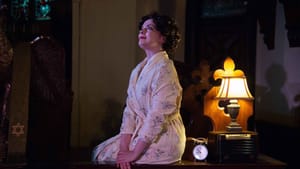Stay in the Loop
BSR publishes on a weekly schedule, with an email newsletter every Wednesday and Thursday morning. There’s no paywall, and subscribing is always free.
A failed escape
Idiopathic Ridiculopathy Consortium presents Elmer Rice’s ‘Dream Girl’

Idiopathic Ridiculopathy Consortium (IRC) recently began expanding its definition of absurdism, branching out to include the works of writers like Tennessee Williams and Jean Anouilh in its programming. This venture has heretofore met with considerable success, but the company’s latest offering, Elmer Rice’s Dream Girl, tests the limits of experimentation.
Rice (1892-1967) ranked among the premier playwrights of his generation but has since been largely relegated to the annals of theater history. Although Tina Brock, IRC’s intrepid artistic director, tries mightily to breathe new life into his bubbly bagatelle from 1945, the results justify his faded reputation.
Remembering Walter Mitty
The elements that drew Brock to the piece are apparent. The plot focuses on Georgina Allerton (Brittany Holdahl), a mild-mannered bookstore clerk given to frequent flights of fancy. Whenever real life becomes too heavy to handle — a publisher rejects her novel; her mother belittles her; her attraction to her brother-in-law remains unrequited — she spins a fantasy that momentarily carries her to a world she can control.
Rice drew inspiration from “The Secret Life of Walter Mitty,” James Thurber’s classic tale of an ordinary man who infused his quotidian life with far-fetched daydreams. Thurber wrote his short story on the eve of WWII, and Rice wrote in its twilight — it’s hard not to link the escapism shared by Georgina and Mitty to a societal desire for diversion, make-believe, and better days ahead. Georgina’s opening line says it all: “Another day — how awful!”
The actual and the imagined
That sounds like capital-A Absurdism to me. Rice’s efforts to make sense of the troubled world by highlighting its very disarray echoes Beckett and Ionesco, IRC’s staple playwrights. Yet Brock’s conception of the piece errs in its lack of contrast between Georgina’s rich inner life and her drab everyday experiences. Pitched somewhere between screwball comedy and sitcom, the actual and the imagined too frequently blend together to create something akin to satire.
The ensemble — which includes Dexter Anderson, Brian McManus, Paul McElwee, Anna Pysher, Kyle Fennie, and Brock herself — each play a handful of parts, doing little to differentiate between stern and lighthearted characters. Whether portraying stern judges or a mariachi band that appears for no apparent reason, they pitch their performances to the point of parody, imitating emotions rather than achieving them. Erica Hoelscher’s overexaggerated costumes and wigs similarly suggest a world in which all and sundry live in a state of unreality.

Why, then, would everyone from Mrs. Allerton (Brock) to the pompous book critic Clark Redfield (Fennie) chastise Georgina for her constant trips to the subconscious? In this conception, aren’t they willing accomplices? As a potential love interest, Clark tries to wrest Georgina from her fabulations, but it never becomes entirely clear where the dream life ends and romance begins.
View from the pews
Joshua L. Schulman’s lighting design tries to demarcate the differing realms, with soft pastel gels for Georgina’s reverie and harsher, unflattering washes for reality. But the blatantly whimsical set decorations (credited to Brock and Mark Williams) telegraph the cluttered space of Georgina’s mind a touch too deliberately. Likewise, Holdahl makes for an excessively self-conscious ingénue.
Dream Girl finds IRC performing in the sanctuary of St. Mary’s Church at Hamilton Village, and the space further hinders whatever progress Brock hoped to make with the play. The auditorium’s dicey dynamics often render the performers inaudible for large stretches of time, and the unraked rows of pews result in treacherous sightlines. I regularly found myself unable to ascertain the provenance of what I was seeing or hearing.
I’m not sure Rice’s quasi-Freudian fantasia would have worked better in a traditional proscenium space. IRC forever deserves commendation for their commitment to a canon most companies wouldn’t go near, but some artifacts are better left unearthed. That’s the harsh reality of Dream Girl.
What, When, Where
Dream Girl. By Elmer Rice, Tina Brock directed. Idiopathic Ridiculopathy Consortium. Through February 24, 2019, at St. Mary’s Church at Hamilton Village, 3916 Locust Walk, Philadelphia. (215) 285-0472 or idiopathicridiculopathyconsortium.org.
Sign up for our newsletter
All of the week's new articles, all in one place. Sign up for the free weekly BSR newsletters, and don't miss a conversation.

 Cameron Kelsall
Cameron Kelsall